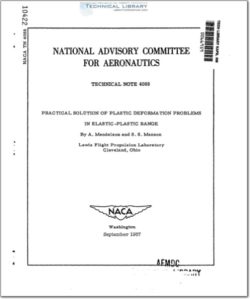naca-tn-4088

- Version
- 175 Downloads
- 2.47 MB File Size
- 1 File Count
- April 19, 2016 Create Date
- April 19, 2016 Last Updated
National Advisory Committee for Aeronautics, Technical Notes - Practical Solution of Plastic Deformation Problems in Elastic-Plastic Range

A practical method for solving plastic deformation problems in the
elastic—plastic range is presented. The method is one of successive
approximations and is illustrated by four examples which include a flat
plate with temperature distribution across the width, a thin shell with
axial temperature distribution, a solid cylinder with radial temperature
distribution, and a rotating disk with radial temperature distribution.
The calculation of stresses in structural components in which plas-
tic flow is considered is currently of great interest in order to take
full advantage of the load-carrying capacity of available materials.
Little attention, however, has been directed at providing simple, general
methods which can be applied by the engineer toward the solution of prac-
tical problems. This report presents such a method and its applications
to several prdblems of current interest. Although use is made of a
technique arising in the theory of integral equations, no knowledge of
integral equations is required, and the mathematics involved is well
within the scope of the practicing engineer.
The method, which is one of successive integrations, is illustrated
for four different thermal stress prdblems which include the flat plate
with temperature variation along the width, the thin cylindrical shell
with axial temperature distribution, the solid cylinder with radial temr
perature distribution, and the rotating disk with radial temperature dis-
tribution. The techniques illustrated are not, however, limited to ther-
mal stress problems. The first three problems considered involve small
plastic strains, that is, on the same order of magnitude as the elastic
strains. The fourth problem involves strains on the order of 1 percent.
The deformation theory of plasticity with the Von Mises yield condition
is used. Other yield conditions, however, could be used.
The determination of stresses and strains in a body consists of com— ‘
bining the equations of equilibrium and compatibility with the "stress—
strain" relation and integrating the resulting equations. For both elas—
tic and plastic problems the same equations result for equilibrium and
compatibility; the difference in the two cases consists of the stress-
strain relation.
| File | Action |
|---|---|
| naca-tn-4088 Practical Solution of Plastic Deformation Problems in Elastic-Plastic Range.pdf | Download |

Comment On This Post